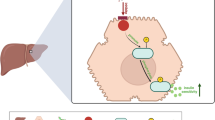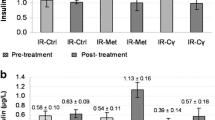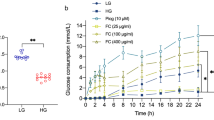Abstract
Key pathways like insulin signaling, AMP activated kinase (AMPK) activation and inflammatory signaling are involved in the complex pathological network of hepatic insulin resistance. Our aim is to investigate whether grape seed proanthocyanidins (GSP) and metformin (MET) target any of these pathways in insulin resistant rat liver. Albino Wistar rats were rendered insulin resistant by feeding a high fat-fructose diet (HFFD). Either GSP (100 mg/kg b.w), MET(50 mg/kg b.w) or both were administered to insulin resistant rats as therapeutic options. HFFD-feeding caused hyperglycemia, hyperinsulinemia, increased gluconeogenesis, decreased tyrosine phosphorylation of insulin receptor-β(IR-β) and insulin receptor substrate-1 (IRS-1) and increased serine phosphorylation of IRS-1. The association of p85α subunit of phosphotidyl inositol 3 kinase(PI3K) with IRS-1 and subsequent Akt phosphorylation were reduced while the expression of mitogen activated protein kinases (MAPK) were increased in HFFD rats. Both MET and GSP reduced hyperglycemia and hyperinsulinemia and improved glycolysis, tyrosine phosphorylation of IR-β and IRS-1, IRS-1-PI3K association and Akt activation. However, activation of tumor necrosis factor-α, interleukin-6, leptin and suppressor of cytokine signaling-3 and reduction in adiponectin caused by chronic HFFD feeding were reversed by GSP better than by MET. Activation of AMPK by GSP was much less compared to that by MET. These findings suggest that GSP might activate PI3K pathway and promote insulin action by reducing serine kinase activation and cytokine signaling and MET by targeting AMPK. The beneficial effects were enhanced during combination therapy. Thus, combination therapy with MET and GSP may be considered for the management of metabolic syndrome.




Similar content being viewed by others
References
Aguirre V, Uchida T, Yenush L, Davis R, White MF (2000) The c-Jun NH2-terminal kinase promotes insulin resistance during association with insulin receptor substrate-1 and phosphorylation of Ser307. J Biol Chem 275:9047–9054
Anithanandhini AT, Balakrishnan SD, Anuradha CV (2002) Taurine modulates antioxidant potential and controls lipid peroxidation in the aorta of high fructose-fed rats. J Biochem Mol Biol Biophys 6:129–133
Bailey CJ, Day C (2004) Avandamet: combined metformin-rosiglitazone treatment for insulin resistance in type 2 diabetes. Int J Clin Pract 58:867–876
Bjorbak C, Lavery HJ, Bates SH, Olson RK, Davis SM, Flier JS, Myers MG Jr (2000) SOCS3 mediates feedback inhibition of the leptin receptor via Tyr985. J Biol Chem 275:40649–40657
Coate KC, Scott M, Farmer B, Moore MC, Smith M, Roop J, Neal DW, Williams P, Cherrington AD (2010) Chronic consumption of a high-fat/high-fructose diet renders the liver incapable of net hepatic glucose uptake. Am J Physiol Endocrinol Metab 299:887–898
Greenberg AS, Obin MS (2006) Obesity and the role of adipose tissue in inflammation and metabolism. Am J Clin Nutr 83:461S–465S
Hokayem M, Blond E, Vidal H, Lambert K, Meugnier E, Feillet-Coudray C, Coudray C, Pesenti S, Luyton C, Lambert-Porcheron S, Sauvinet V, Fedou C, Brun JF, Rieusset J, Bisbal C, Sultan A, Mercier J, Goudable J, Dupuy AM, Cristol JP, Laville M, Avignon A (2013) Grape polyphenols prevent fructose-induced oxidative stress and insulin resistance in first-degree relatives of type 2 diabetic patients. Diabetes Care 36:1454–1461
Johnston AM, Pirola L, Van Obberghen E (2003) Molecular mechanisms of insulin receptor substrate protein-mediated modulation of insulin signaling. FEBS Lett 546:32–36
Kaur M, Singh RP, Gu M, Agarwal R, Agarwal C (2006) Grape seed extract inhibits in vitro and in vivo growth of human colorectal carcinoma cells. Clin Cancer Res 12:6194–6202
Kershaw EE, Flier JS (2004) Adipose tissue as an endocrine organ. J Clin Endocrinol Metab 89:2548–2556
Li XM, Li Y, Zhang NN, Xie YH, Shi YQ (2011) Combination therapy with metformin and fenofibrate for insulin resistance in obesity. J Int Med Res 39:1876–1882
Lowry OH, Rosebrough N, Farr AL, Randall RJ (1951) Protein measurement with the Folin phenol reagent. J Biol Chem 193:265–725
Medina EA, Afsari RR, Ravid T, Castillo SS, Erickson KL, Goldkorn T (2005) Tumor necrosis factor-{alpha} decreases Akt protein levels in 3T3-L1 adipocytes via the caspase-dependent ubiquitination of Akt. Endocrinology 146:2726–2735
Miller BS, Shankavaram UT, Horney MJ, Gore ACS, Kurtz DT, Rosenzweig SA (1996) Activation of cJun NH2-terminal kinase/stress-activated protein kinase by insulin. Biochemistry 35:8769–8775
Montagut G, Onnockx S, Vaqué M, Bladé C, Blay M, Fernández-Larrea J, Pujadas G, Salvadó MJ, Arola L, Pirson I, Ardévol A, Pinent M (2010) Oligomers of grape-seed procyanidin extract activate the insulin receptor and key targets of the insulin signaling pathway differently from insulin. J Nutr Biochem 21:476–481
Otero M, Lago R, Lago F, Casanueva FF, Dieguez C, Gómez-Reino JJ, Gualillo O (2005) Leptin, from fat to inflammation: old questions and new insights. FEBS Lett 579:295–301
Phillips L, Prins J (2008) The link between abdominal obesity and the metabolic syndrome. Curr Hypertens Rep 10:156–164
Rabe K, Lehrke M, Parhofer KG, Broedl UC (2008) Adipokines and insulin resistance. Mol Med 14:741–751
Sarraf P, Frederich RC, Turner EM, Ma G, Jaskowiak NT, Rivet DJ 3rd, Flier JS, Lowell BB, Fraker DL, Alexander HR (1997) Multiple cytokines and acute inflammation raise mouse leptin levels: potential role in inflammatory anorexia. J Exp Med 185:171–175
Strowig SM, Raskin P (2005) Combination therapy using metformin or thiazolidinediones and insulin in the treatment of diabetes mellitus. Diabetes Obes Metab 7:633–641
Suwannaphet W, Meeprom A, Yibchok-Anun S, Adisakwattanna S (2010) Preventive effect of grape seed extract against high-fructose diet-induced insulin resistance and oxidative stress in rats. Food Chem Toxicol 48:1853–1857
Taniguchi CM, Brice E, Kahn CR (2006) Critical nodes in signaling pathways: insights into insulin action. Nat Rev Mol Cell Biol 7:85–96
Terra X, Montagut G, Bustos M, Llopiz N, Ardèvol A, Bladé C, Fernández-Larrea J, Pujadas G, Salvadó J, Arola L, Blay M (2009) Grape-seed procyanidins prevent low-GSPde inflammation by modulating cytokine expression in rats fed a high-fat diet. J Nutr Biochem 20:210–218
Ueki K, Kondo T, Kahn CR (2004) Suppressor of cytokine signaling 1 (SOCS-1) and SOCS-3 cause insulin resistance through inhibition of tyrosine phosphorylation of insulin receptor substrate proteins by discrete mechanisms. Mol Cell Biol 24:5434–5446
Werner ED, Lee J, Hansen L, Yuan M, Shoelson SE (2004) Insulin resistance due to phosphorylation of insulin receptor substrate-1 at serine 302. J Biol Chem 279:35298–35305
Whitehead JP, Richards AA, Hickman IJ, Macdonald GA, Prins JB (2006) Adiponectin—a key adipokine in the metabolic syndrome. Diabetes Obes Metab 8:264–280
Winder WW, Hardie DG (1999) The AMP-activated protein kinase, a metabolic master switch: possible roles in type 2 diabetes. Am J Physiol 277:E1–E10
Yousef MI, Saad AA, El-Shennawy LK (2009) Protective effect of grape seed proanthocyanidin extract against oxidative stress induced by cisplatin in rats. Food Chem Toxicol 47:1176–1183
Zhou G, Myers R, Li Y, Chen Y, Shen X, Fenyk-Melody J, Wu M, Ventre J, Doebber T, Fujii N, Musi N, Hirshman MF, Goodyear LJ, Moller DE (2001) Role of AMP-activated protein kinase in mechanism of metformin action. J Clin Invest 108:1167–1174
Acknowledgments
We gratefully acknowledge the Indian Council of Medical Research (ICMR), New Delhi, for providing financial assistance in the form of Senior Research Fellowship (SRF) to the first author, Yogalakshmi. B.
Author information
Authors and Affiliations
Corresponding author
Rights and permissions
About this article
Cite this article
Yogalakshmi, B., Bhuvaneswari, S., Sreeja, S. et al. Grape seed proanthocyanidins and metformin act by different mechanisms to promote insulin signaling in rats fed high calorie diet. J. Cell Commun. Signal. 8, 13–22 (2014). https://doi.org/10.1007/s12079-013-0210-x
Received:
Accepted:
Published:
Issue Date:
DOI: https://doi.org/10.1007/s12079-013-0210-x




